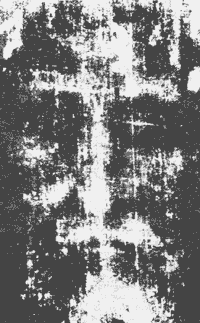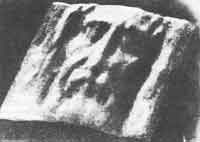A Book Review: A Photograph of the Resurrection?

by Malcom Brennan
THE SHROUD OF TURIN:
The Burial Cloth of Jesus Christ?
by Ian Wilson
Rev. ed. 1979.
Doubleday Image Books
Paperback $3.95
Those distressed by assaults on the traditional faith from all directions must take great consolation from recent discoveries concerning the Shroud of Turin. This book is the only one I know of that gives a comprehensive, authoritative account for laymen of recent scientific studies of the Shroud. In addition it gives Wilson's own valuable contributions toward a history of the Shroud.
|
The image of the Man on the Holy Shroud of Turin. It is possible to count more than 600 wounds imprinted on the flesh. |
The author usually maintains an objective point of view, with a rather studied ecumenical stance—in order, no doubt, to gain the widest possible hearing for his message. Occasionally, however, his Catholic perspective and his personal veneration for the great relic come through. He casts the narrative somewhat in the form of a detective story, letting us share the suspense of the investigators and the surprising turns of events. It is quite exciting to read.
The modern story of the Shroud begins in 1898 when Secunda Pia made the first photograph of it. To the naked eye, Wilson reports, the figure on the linen is discernible but ill-defined, with tones resembling the discolorations on a well-used ironing board cover. Pia's glass negative, however, to his utter astonishment, showed the figure in much more detail. Apparently the picture on the Shroud is some kind of photographic negative, and Pia's negative of that negative revealed an abundance of unexpected information.
Subsequent examinations of the Shroud have been mainly attempts to discover whether it could be some kind of hoax, an opinion held by many pious and learned Catholics until recent times. For most of us it is sufficient to reflect that it would be quite preposterous that someone before about 1357 (when the undisputed recorded history of the Turin Shroud begins) should perpetuate a deception which could not deceive until the invention of photography. But the scientist—bless his suspicious soul—must check out every possibility, and in doing so has discovered even greater surprises. The Shroud has been tested for paint, brush strokes, sweat, blood, ammonia, funeral oils and spices, and any other substance that might account for the image. Chemical and microscopic examinations have revealed no 'stain' at all; the pigmentation was found to be wholly on the surface of the cloth and had not penetrated even individual fibers, so that whatever made the image did not soak in even slightly. Besides, attempts to produce a picture by blotting make a terribly distorted image, in sharp contrast to the handsomely proportioned man in the Shroud.
Various tests and observations contribute to reveal a wealth of information about the body which the Shroud enclosed. He was 5 feet 10 1/2 or 11 inches tall, weighed about 175 pounds, of good build, had one shoulder slightly larger than the other (from carpentry? or a quirk of rigor mortis?), had numerous wounds all over the head (as from a cap of thorns), severe bruises on the face, on the knees (as from falling), and on the shoulders (as from carrying a large timber). He had received from 90 to 120 lashes delivered by whips with either two or three tongs, each tipped with a small dumbbell-shaped weight, delivered by two men, one taller and stronger than the other, with the lashes landing mostly on the back of the torso and legs but occasionally whipping around to the front. He had been crucified by means of a large nail through each wrist, and one nail passing through both feet, had his arms extended now at 55°, now at 65° (according as he raised himself with his feet to ease the pain in his arms and facilitate breathing), had a large puncture between the 5th and 6th ribs, on the right hand side, from which flowed a large amount of blood and a clear fluid. There were no broken bones. The body was not washed or dressed for burial but had its ankles tied together, its hands tied before the groin, a band tied over the head and under the chin, and a coin placed over each eye—these last items in accord with Jewish burial customs of the first century.
In 1976 a young Air Force officer placed a 3 x 5 photograph of the face into a device at the Sandia Laboratory called an Interpretation Systems VP-8 Analyzer, an image enhancing machine developed for interpreting data from space explorations. He did not expect much because the device is ordinarily used with two photographs of an object or surface, like Mars, taken with a known distance between them; it combines data from the two photographs and produces an image in relief. To the officer's amazement, the screen of the VP-8 immediately showed a beautiful picture in relief of a dignified face in serene repose, which the machine permits one to turn this way and that. (It was here that the coins on the eyes were discovered.) This part I may not understand properly: The picture seems to mean that the 'photograph' on the Shroud was not made through a single focal point, but that there is a point for point correspondence between the body and the Shroud, and that the intensity of each point in the image corresponds to the distance between that point and the body. (The pictures reproduced with this article are not from Wilson's book, whose photographs are disappointingly small, but from The Catholic Counter-Reformation in the XXth Century, no. 117.)
|
|
Such unexpected qualities of the image have led scientists to the most fascinating hypothesis of all, that the image was formed by scorching, the oxidation that occurs just before burning. It seems to have been caused by a very brief (in the order of milliseconds) but very intense burst of thermal radiation emanating from the corpse— at the very moment (the believer completes the scientist's hypothesis), at the very instant of Our Lord's return to and glorification of His Body. It is curious to think that the blood and sweat of the tortured body did not simply lapse into nothingness but was perhaps vaporized and carbonized (like the spills in your self-cleaning oven) in a process which left their imprint on the Shroud. We sometimes forget that a miracle, being a physical event in part, is subject to scientific description in part.
Wilson's book is filled with data that leads to such reflections on the details of the Crucifixion and Resurrection. However, these matters he reports as an outside observer; his own original research is historical, and it occupies over a third of the book. As noted already, the undisputed recorded history of the Turin Shroud (there have been several other Shrouds) begins in the late 1350's. In Constantinople from the 10th to the 13th centuries there was venerated a relic called the Mandylion, an image 'not made by hands' on cloth showing the face of the suffering Christ. Wilson offers the hypothesis that the Mandylion and the Shroud are one—which is not so simple an identification as it might appear. Even so, there is a gap between 1204, when the Mandylion disappeared without a trace during the sack of Constantinople by crusaders, and about 1357, when the Shroud just as mysteriously surfaced in the possession of a modest French family who absolutely refused to explain to skeptical clerics where the stupendous relic came from. Another Wilson hypothesis: It had been in the possession of the secretive and powerful order of Knights Templar, who were violently suppressed in 1307. One of the many charges leveled against the Knights was that they secretly worshipped an idol which they blasphemously called their savior.
For the period when the Mandylion was in Edessa, its history is a combination of verifiable fact, curious legend and strange tale. Wilson shows himself to be a judicious and wise historian as he picks through this formidable material to find plausible grains of truth. Undoubtedly there remain large gaps in Wilson's account and many corrections and refinements to make on it, but in general the outline has the ring of truth about it.
In his introduction Wilson speaks of a quiet revolution being caused by the Shroud, which as yet is a barely respectable subject in scientific and academic circles. If we ask how it can be that historians, archaeologists, biblical scholars, theologians, and the like can continue to ignore so cogent a piece of evidence about Christ's life, we need only recall his words, "If they hear not Moses and the prophets, neither will they believe, if one rise again from the dead" (Luke 16:31).
|
The face on the Shroud as revealed by the VP-8 Analyzer, with blood and wounds electronically removed. |
The relic, then, may not convert the world, but I believe, like Wilson, that it will begin to have a profound impact.
While the Shroud may not persuade a particular biblical scholar to interpret some Greek or Aramaic word of Scripture literally as well as symbolically, yet I would dare to predict that it will become so commanding a presence in the world that it will lend credibility to the literal, material truth of early records of the faith. As we are all too aware, the life of Christ is for many just a fable, the infancy narratives are merely pious legends, the miracles have only symbolical value and the parables and sayings have no objective content but only psychological impact, and the risen Christ is actually a memory of what never was, a memory made psychologically real by the hopes, fears, and nostalgia of a beleaguered minority of early Christians.
Yet, "if Christ be not risen again, then is our preaching vain: and your faith is also vain" (I Cor. 15: 14). And we, alas, have become heirs to religions made out of human vanities and for human vanities. Perhaps the Shroud will in time give the death blow to the 150 year-old program of turning Scripture (and lately Catholicism) into a myth, and will help to return a penitential spirit to our hedonistic age.
When St. John recorded the Crucifixion, he saw it as a fulfillment of a 500 year old prophecy by Zacharias: "They shall look on him whom they have pierced." Who could have imagined that the prophet's words would be fulfilled again in the twentieth century?
Dr. Brennan is Professor of English at The Citadel in Charleston, South Carolina.



